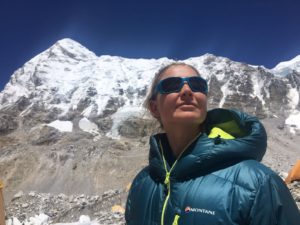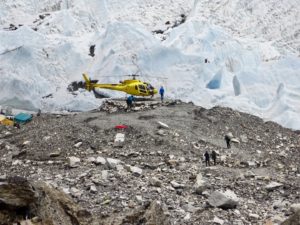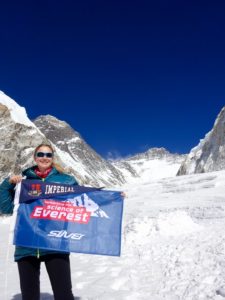The last couple of weeks have been just waiting. We have been at base camp biding our time, spending our days walking, eating, napping, chatting and playing cards. It’s actually quite relaxing, provided you don’t allow yourself to get impatient about the next step – when will we be going up the mountain?
However, whilst the climbers have been resting there has been a lot of activity higher up the mountain. There is a lot to be organised; a lot to be moved into place, quite literally. Over the last couple of weeks Sherpas have been carrying loads up the mountain to supply higher camps. There are tents, sleeping mats, stoves, gas, food and oxygen that need to be carried to camps 3 and 4 ready for the climbers coming up. As well as that, Sherpa teams have been fixing ropes to the summit. These are safety lines that the climbers clip into in case of falls.
 Waiting at base camp
Waiting at base camp
This intricate dance is coordinated from base camp, often with cooperation between the major teams. Radio communications are imperative here for discussion between camps up the mountain. The Sherpas carry portable Icom radios so they can keep in touch with base camp.
Whilst all this is going on we are watching the weather. We are looking for a “window” of good weather – a stable period of about four days or so, particularly with low winds. When all the equipment is in place and the ropes are almost fixed then the teams start to move. Early teams may move up to camp 2 and on to camp 3 to be in position for when the ropes are fixed and the winds drop. Others will come later, due to personal choice or logistics. For example, we have two groups, which will climb one after another with the same Sherpa support. Climbers can usually summit up until the end of May or into June before the monsoon comes, so there is time.
 Helicopters fly in and out several times a day for logistics, but are also important for rescue if anything goes wrong
Helicopters fly in and out several times a day for logistics, but are also important for rescue if anything goes wrong
An increased understanding of weather systems, and better computing and modelling capabilities have had a huge positive effect on weather forecasting over the last 30 years. This helps with planning on the mountain and contributes to improving safety, as does the improvement in reliability of communications. Being here on the mountain we can see the practical implications of these developments.
But perhaps the most noticeable difference in the field of communications is the connectivity at base camp that keeps us in touch with the outside world. There is NCell phone signal during daylight hours so that we can make phone calls home; camps have wifi powered by solar panels that keeps us connected via email, messengers or social media. Higher up the mountain we have satellite phones to keep in touch. This isn’t necessary to the safety of the expedition, but it is good for our morale and nice for family and friends.
So, whilst we are keen to get up the mountain and go for the summit, it has been interesting to get a glimpse of the logistics dance in action and to get an appreciation of how developments in science and technology improve the process.


